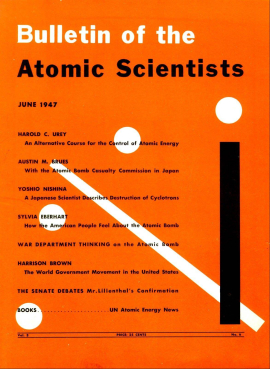On January 20, the Bulletin of the Atomic Scientists will begin celebrating the 75th anniversary of its iconic Doomsday Clock. Since 1947, the clock has kept track of the likelihood of man-made annihilation and now stands at 100 seconds to midnight, a metaphor for hypothetical global catastrophe. The clock has been moved backward eight times and forward 16 times—the farthest being 17 minutes in 1991, the nearest being 100 seconds in 2020 and 2021. The Bulletin will announce the new 2022 time on the 20th.
“The Doomsday Clock is the iconic image that visually conveys the Bulletin’s mission of alerting the public of existential threats,” said Rachel Bronson, president and CEO of the Bulletin, an independent media nonprofit that also publishes a digital magazine. “It has become synonymous with and serves as a beacon of our work, universally understood in any language. We are at a more dangerous place now than during the Cold War.”
“Managing the clock is an enormous responsibility,” she continued. “It is discussed in thousands of news stories around the world, and millions engage with it throughout the year. The time is a blunt measurement, but it generates a global conversation, and we take it very seriously.”
The Bulletin warns against humanity’s scientific and technical advances, especially when unchecked. This includes advocating for nuclear disarmament and a stop to the “huge investment in nuclear weapons,” says Bronson, who believes today countries “act as if use of nuclear weapons is on the table.”
She has a point: Not much debate followed Biden’s $1.3 trillion national security budget—more than double the yearly cost of the Build Back Better plan, currently languishing in the Senate due to bad-faith attacks about its cost. In 2020, nuclear weapons spending increased by $1.4 billion, as the nine nuclear armed countries spent $72.6 billion on nuclear weapons.
Bronson says she was hopeful about recent U.S.-Russia and U.S.-China dialogues, but she’s disappointed with China’s absence from the recent COP 26. She says the U.S.-Chinese bilateral agreement was not as “significant as reality requires.” The newfound acknowledgement of the consequences of climate change, however, shows “humanity is feeling the change, and people are pressuring their politicians,” demanding action.
While not originally part of the Bulletin back in 1945, the scientists working on the Manhattan Project added a clock to the cover of its first bound magazine in 1947. Landscape artist Martyl Langsdorf (married to Alexander Langsdorf, a scientist on the Manhattan Project) says she set the hands of the Doomsday Clock to at seven minutes to midnight because it “looked visually appealing.”
Focused on Nuclear Risk, Climate Change and Disruptive Tech
Bulletin’s Board of Sponsors was established in 1948 by Albert Einstein, and J. Robert Oppenheimer was its first chair. Founded by concerned scientists as “a public reckoning in the aftermath of the atomic bombings of Hiroshima and Nagasaki,” its creation was seen as an emergency action—an emergency that persists today.

These days, the magazine is distributed to 10,000 libraries worldwide. Prior to the Trump presidency, the Bulletin’s online site averaged 2 million site visitors and 4 million page views. But beginning in 2020, site visits nearly doubled to 4.4 million visitors and 7.4 million page views. The organization is currently on pace to match 2020’s success.
Half the organization’s site visitors are “under 35 years old” and from outside the U.S., says Bronson. Her take: Young people “don’t need to be told; they know it, and want to know what to do about it.”
Supported by its three boards—Sponsors; Science and Security; and Governing—the Bulletin aims to deliver sound debates by way of well-crafted opinions from expert writers and scientists who manage and assess scientific risk. In it, security experts discuss the implications of science as it moves through political process and report on the advancement of science. The publication is funded primarily by private and foundational grants, as well as magazine revenue. It’s also received support from the government of Norway in the past for its focus on disarmament.
The Bulletin’s has three man-made focus areas: nuclear risk, climate change and disruptive technologies. But nuclear risk is the backbone of its mission, according to co-founder Eugene Rabinowitz, whose goal was “to awaken the public to the full understanding of the horrendous reality of nuclear weapons.” The Bulletin’s 2009 decision to add climate change to the clock statement “was one of the most controversial decisions,” says Bronson. It made some wonder if the Doomsday Clock was about nuclear threat or existential threat. It’s the latter, she says. More areas of institutional focus are also forthcoming, and “existing ones overlap in important ways.”
Setting the Doomsday Clock each year is meant to carry a message of hope and remind us we have the ability to reduce these seemingly insurmountable threats and of our responsibility to future generations. It tells us we can beat the odds.
How does the organization pressure world leaders for more responsible actions across its focus areas? Bronson says Bulletin articles equip “activists with the ammunition” to organize communities and keep pressure on political leaders worldwide.
“Activists are important. Smart activists are unstoppable,” said Bronson.

The Bulletin’s Nuclear Notebook tracks the nine nuclear countries—U.S., Russia, U.K., China, Pakistan, India, Israel, North Korea and South Korea—and monitors aspiring nuclear countries, like Iran. But its focus is the critical, and at times adversarial, relationship between the U.S. and Russia, which together own 90 percent of the world’s nuclear arsenal.
Among the Bulletin’s landmark achievements:
- Its citizen-scientist movement in the ’40s and ’50s introduced the Doomsday Clock as “a symbol that engages the public.”
- In the late ’50s and early ’60s, it introduced climate change and declared it a “human-made threat.”
- It played a central role in the 1970s and ’80s arms control debate.
- More recently, the Bulletin’s innovative work on biosecurity positioned it as a central player in the origins of COVID debate.
Bronson warns their published research and discussions are not for the “faint of heart” but believes a “well-informed public is a powerful group that can bring about change.”
“The Bulletin asserts we are at a world-saving moment and each of us has a role to fulfill,” said Bronson. “We’ve turned the hands of the Doomsday Clock back before and surely; we can do it again. It’s a call-to-action to citizens worldwide to work toward moving the hands away from midnight. And it’s a challenge for our decision-makers to do better.”
“We are perilously close, closer than we’ve ever been, to a man-made point of no return,” she continued. “But setting the Doomsday Clock each year is meant to carry a message of hope and remind us we have the ability to reduce these seemingly insurmountable threats and of our responsibility to future generations. It tells us we can beat the odds.”
Bronson will host the virtual event on Jan. 20, as well as organize programming and lectures about the ‘time’ in the weeks after the announcement. Events throughout the year will urge actions by citizens and governments worldwide. Ultimately, the hope is that politicians worldwide will take tangible, real actions—but Bronson knows it won’t happen without citizen pressure, as history has proven.
“The groundswell worldwide, as people experience climate change, is forcing leaders to answer hard questions. We see it in the climate space—a bright spot that has increased public awareness and pressure forcing corporations and leaders to put sustainable programs in place and thinking their way through this.”
Up next:





